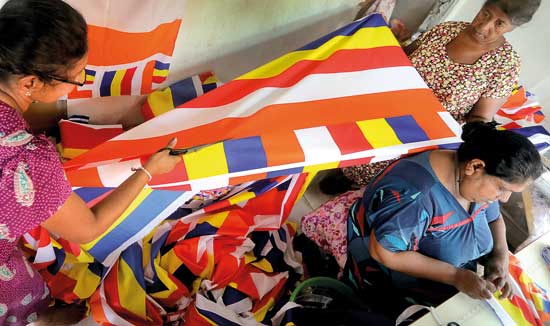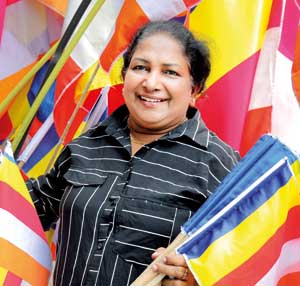From the first Buddhist flag unfurled in 1885 to a shop called Deepaduththara
It decks the roads and evokes faith in the hearts of Buddhists each Vesak- the colours of the Buddha’s res or aureole soothing the soul in the full moon night, when serene light and calmness is everywhere…
We must look back to the Buddhist revival in colonial Ceylon to get a glimpse of the birth of the Buddhist flag. A great number of oppressed Buddhists, both leading monks and lay leaders had taken it upon themselves to win back for their religion its erstwhile position in the country. They envisaged a universal symbol for Buddhism in the shape of a flag.

Deepika’s workshop: A hive of activity. Pix by M.A. Pushpa Kumara
Among them were Ven. Hikkaduwe Sri Sumangala Thera, Ven. Migettuwatte Gunananda Thera, Don Carolis Hewavitarne (father of Anagarika Dharmapala), Andiris Perera Dharmagunawardhana (maternal grandfather of Anagarika Dharmapala), Charles A. de Silva, Peter De Abrew, William De Abrew (father of Peter), H. William Fernando, N. S. Fernando and Carolis Pujitha Gunawardena.
They had drafted a memorandum addressed to Lord Derby, the Colonial Secretary, aimed at gaining emancipation from the injustices Buddhists were suffering under British rule. Among the requests in the memorandum were that Vesak full moon poya should be made a public holiday. Colonel Henry Steele Olcott undertook to go and meet Lord Derby.
About the proposed flag Olcott was to note in his diary:

K. Deepika: Sewing flags for three decades
“It was at this time that our Colombo colleagues had the happy thought of devising a flag which would be adopted by all Buddhist nations as the universal symbol of their faith thus serving the same purpose as that of the cross does for all Christians. It was a splendid idea and I saw in a moment its far-reaching potentialities as an agent in that scheme of Buddhist unity. Our Colombo brothers had hit upon the quite original and unique idea of blending in the flag the six colours alleged to have been exhibited in the aura of the Buddha.”
Carolis Pujitha Gunawardena is generally held to be the designer of the flag. At first it was shaped like a streaming pennant but Colonel Olcott objected, opting instead for a rectangular form like a national flag.
Thus the brand new Buddhist flag was first flown in 1885 on the first Vesak day that was a public holiday in Ceylon.
Down busy Baseline Road in Colombo 10 is K. Deepika Hemamali’s small workshop, a hive of activity overflowing with yards and yards of ‘neela, peetha, lohitha, odatha and manjistha’ (blue, yellow, red, white and orange in both Pali and Sanskrit). Eight dedicated seamstresses work under Deepika to produce, in varying sizes, flags – from those to fly on your car flag pole to those that can cover a skyscraper in Colombo head to toe.
She has been sewing Buddhist flags for more than three decades.
Deepika’s (or Deepa’s) shop is called Deepaduththara and therein lies a tale. The first location where the nascent Buddhist flag was flown, in 1885, was the Dipaduttaramaya, Kotahena, where that fiery Buddhist orator, the Ven. Migettuwatte Gunananda Thera, resided. For Deepa, her flag shop is much more than a business. She says with fervour that she must have acquired a lot of pin (religious merit) in previous lives to be thus making Buddhist flags today. She bought her first Singer sewing machine some 30 years back (when she was about 18) with Rs. 3000 — money saved from a “gentleman called Mohammed in Maradana”.
Under the light of a single chimney lamp, she worked on the first flags. Later her husband and three sons joined and today her business has such renown that monks from Germany, Canada, Italy, Japan, Myanmar and Nepal place orders with her.
Further down Baseline Road in Orugodewatte, we also meet Andaramanage Kanthi who buys her flags from Pettah. Sales have been low this year so far, what with the elections coinciding, but hopefully things will pick up this week, she says with a stoical smile.
| What the colours mean | |
| By Udumbara Udugama Displayed prominently in Buddhist homes and other establishments during Vesak, the Buddhist flag has five vertical columns with the sixth column being a combination of all five colours. These six colours represent the aura believed to have emanated from the body of the Buddha when He attained Supreme Enlightenment. Blue (Nila) -represents the universal compassion (karuna), unconditional loving kindness. Yellow (Pita) – the middle way (avoidance of self-indulgence and self -mortification), right view, right aspiration, right speech, right action, right livelihood, right effort, right mindfulness and right concentration. Red (lohitaka) – blessings of practice White (odata/ovadata)- purity of Dhamma leading to liberation Orange (manjettha) - wisdom Combination of the five colours – aura of the truth of the Buddha’s Teachings – essence of light (pabbhassara). Each of these colours represents a particular quality of the Buddha. In 1885, the flag appeared in the ‘Sarasavil Sandaresa’, a Sinhala newspaper supported by David Hewavitarne later known as Anagarika Dharmapala. The money they received from its sales was used to contribute to the maintenance of small schools. The flag was adopted as the International Buddhist Flag by the World Buddhist Congress in 1952. |
Searching for an ideal partner? Find your soul mate on Hitad.lk, Sri Lanka's favourite marriage proposals page. With Hitad.lk matrimonial advertisements you have access to thousands of ads from potential suitors who are looking for someone just like you.


